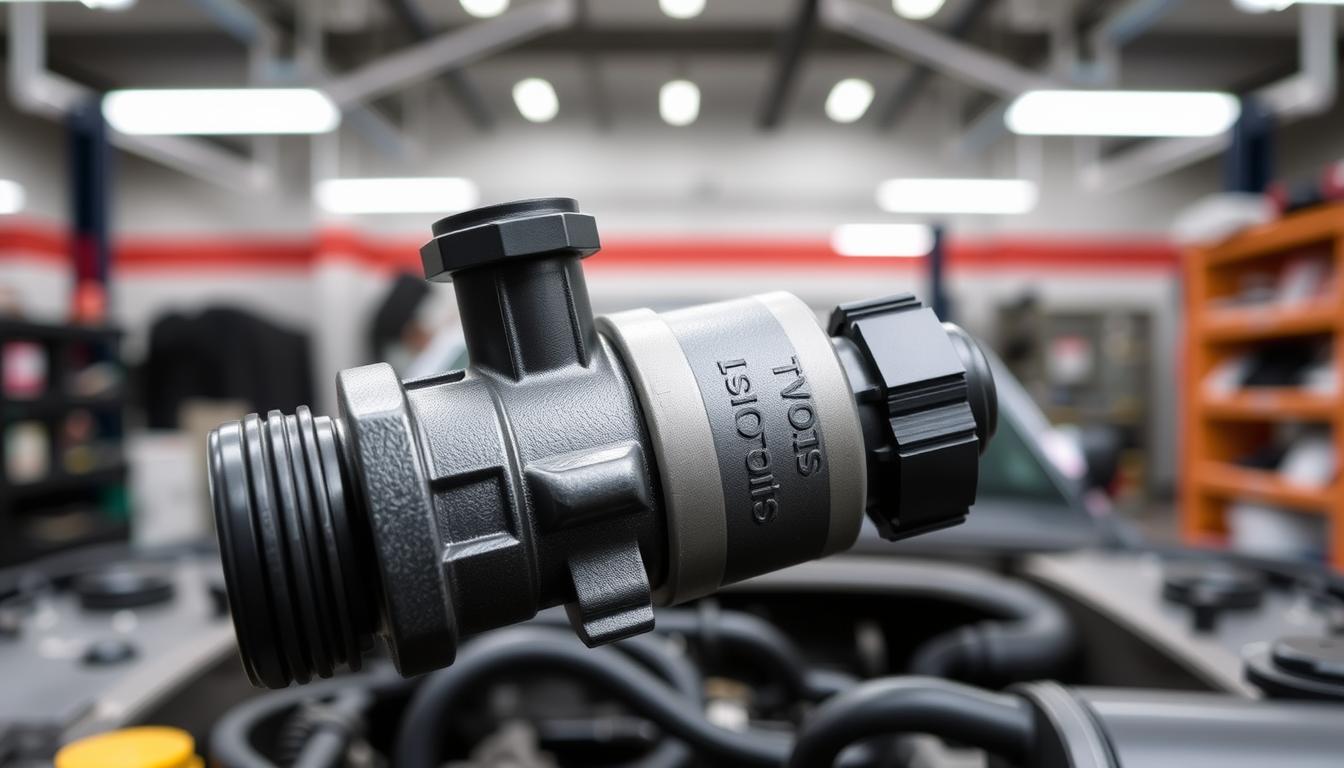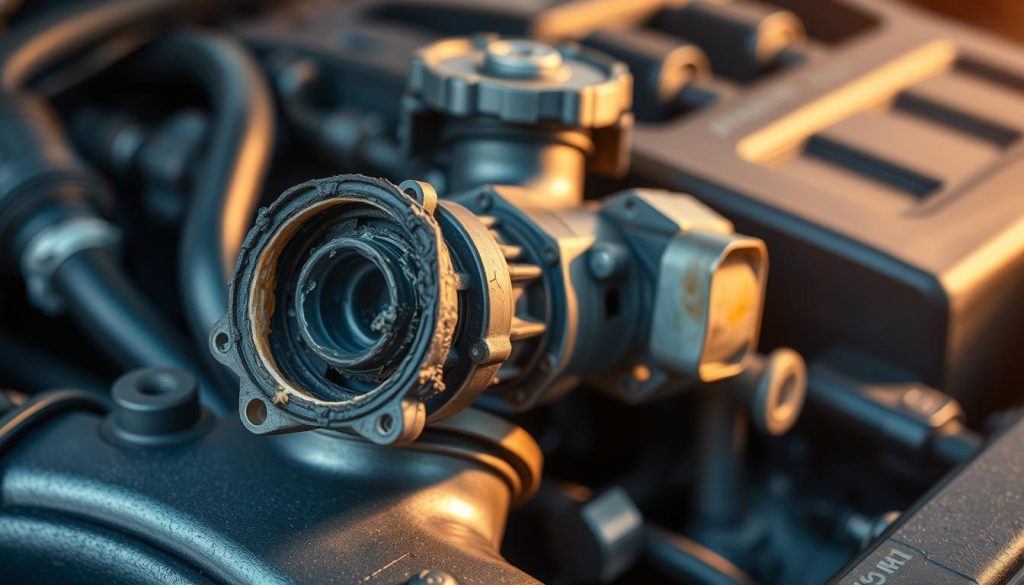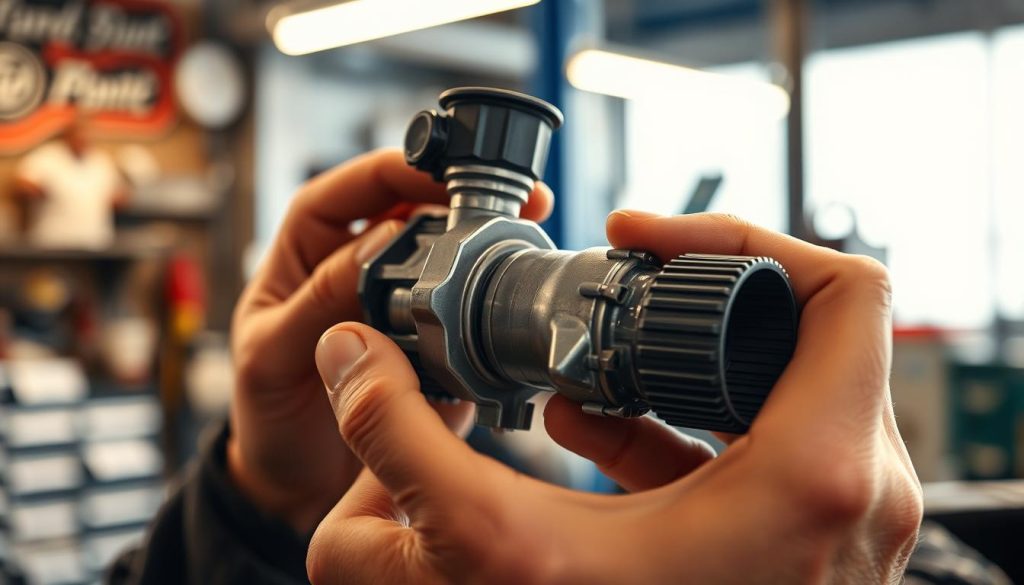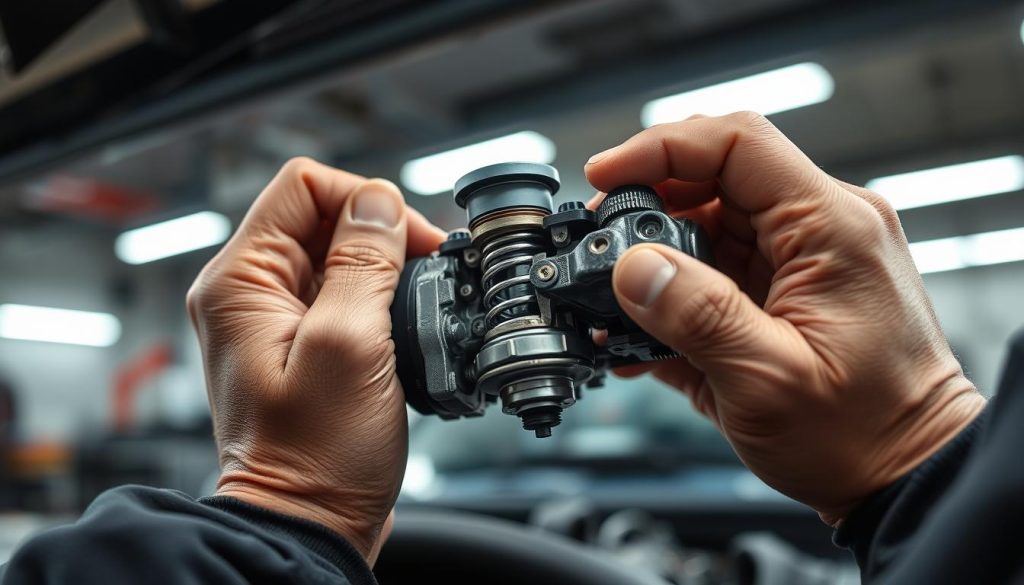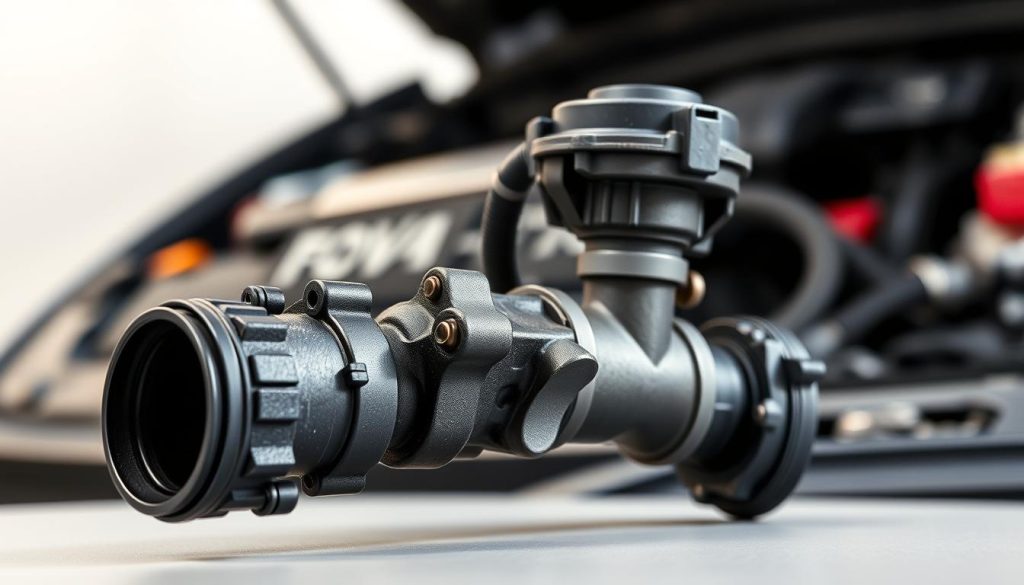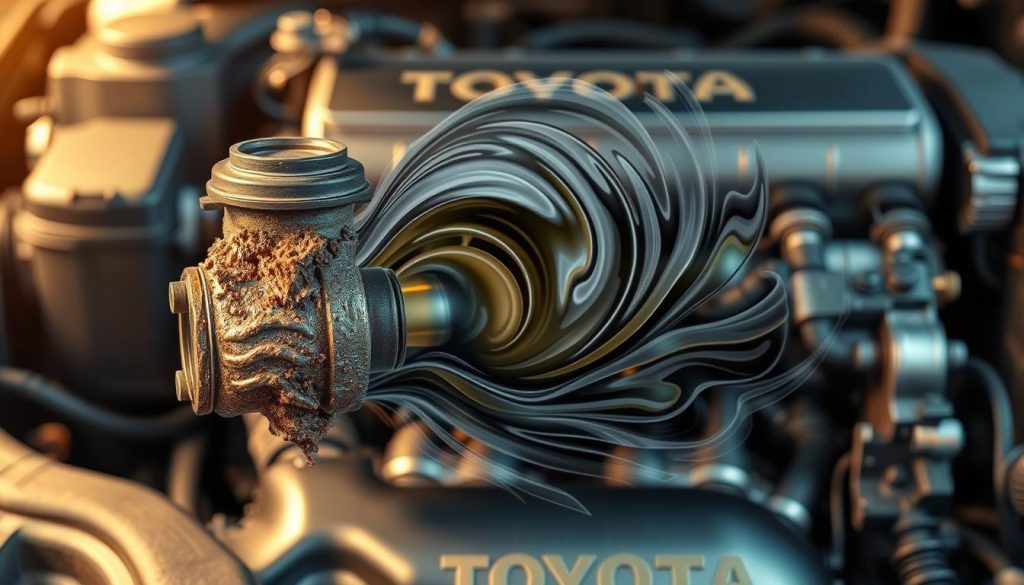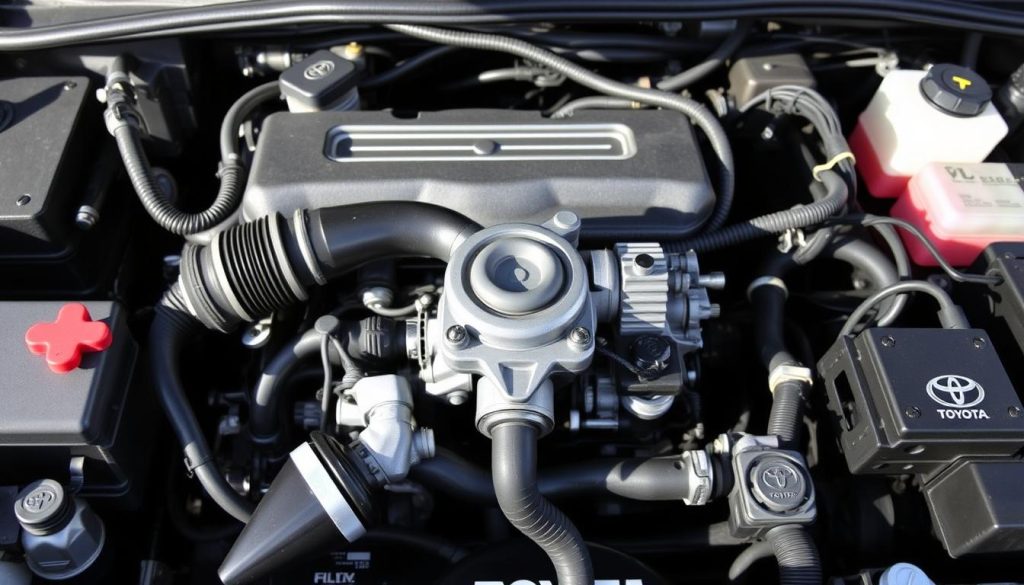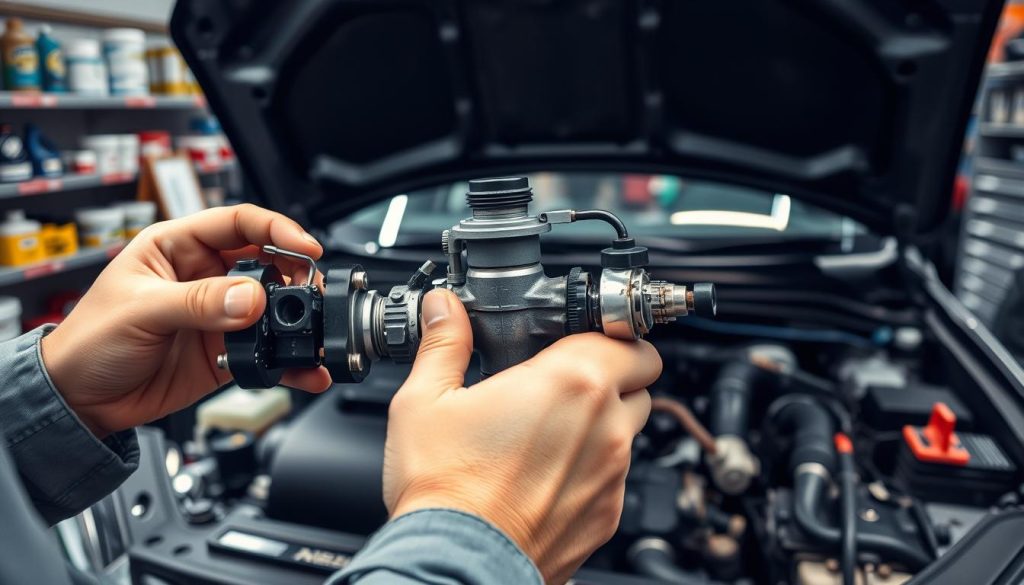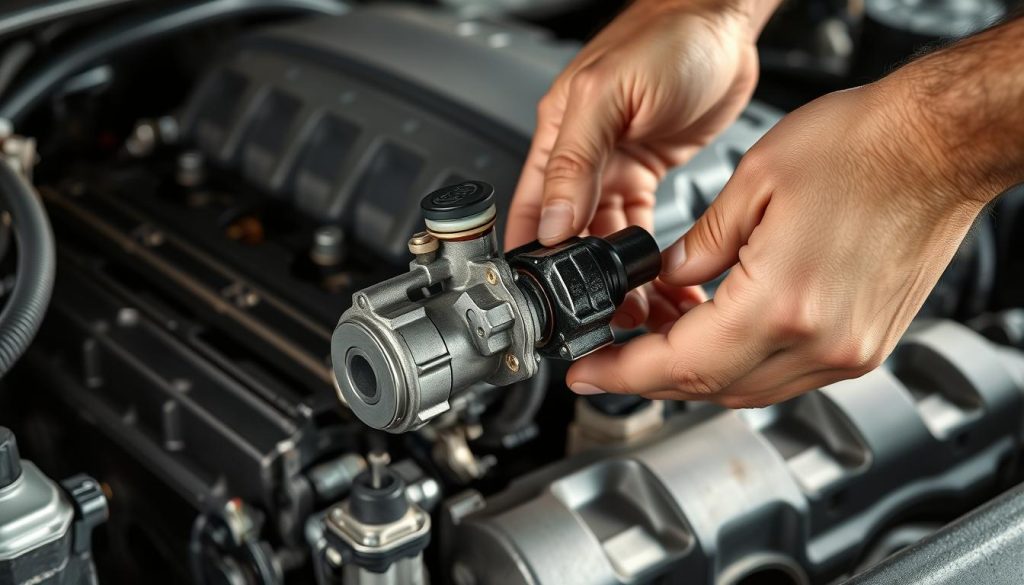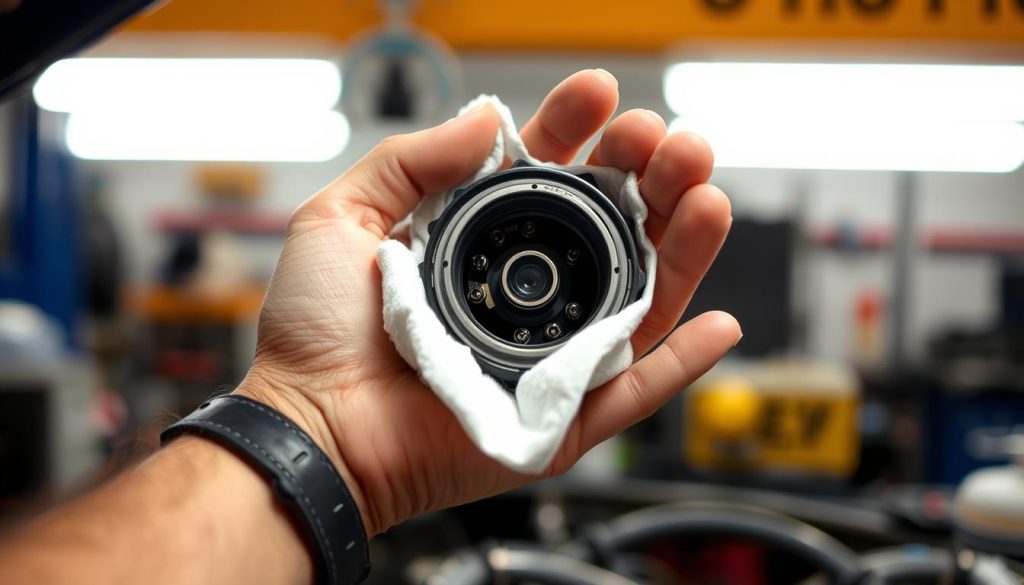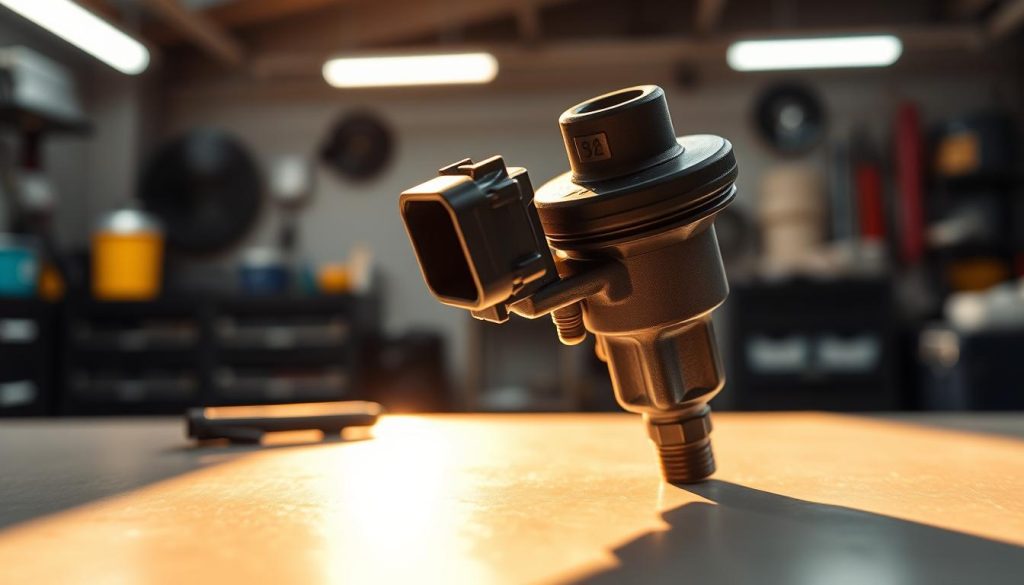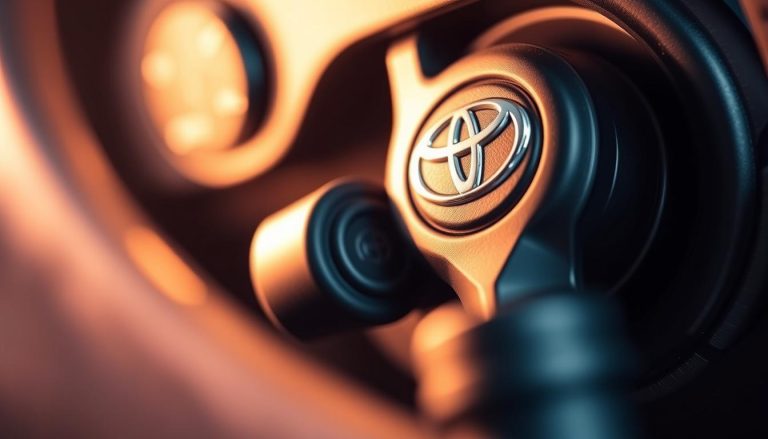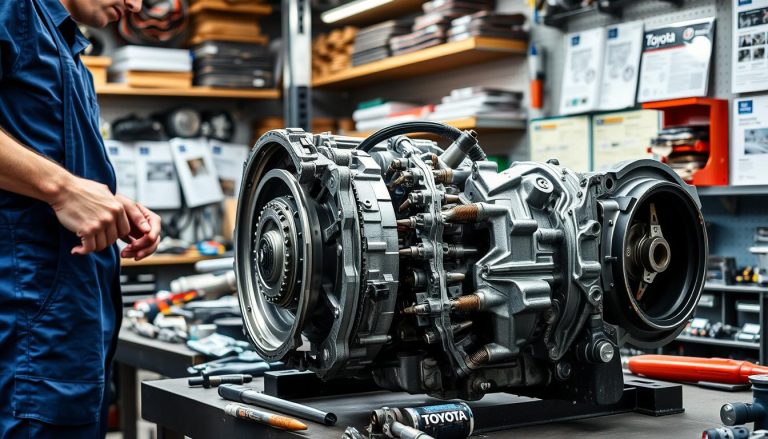How to Fix Toyota PCV Valve Issues
Fixing Toyota PCV valve problems is key to keeping your car running well. The PCV valve helps control engine pressure and emissions. Knowing how to fix it is important for your car’s health.
In this guide, we’ll show you how to find and fix PCV valve issues. You’ll learn how to spot problems and replace the valve correctly. This will help your Toyota run smoothly and efficiently.
Understanding the PCV valve’s role and its common problems is the first step. This way, you can catch issues early and prevent bigger problems. Whether you’re doing it yourself or getting help from a pro, this guide will help you make the right choices for your Toyota’s maintenance.
Understanding the Role of a PCV Valve in Toyota Vehicles
The PCV (Positive Crankcase Ventilation) valve is key in Toyota cars. It helps manage engine pressure and keeps the engine running well. It sends harmful gases away from the engine, making it more efficient and cutting down on emissions.
https://www.youtube.com/watch?v=onu3XAYhH9M
Definition and Function
The PCV valve controls the release of bad gases from combustion. It sends these gases back into the engine, stopping them from getting out. This cuts down on pollution and keeps the engine running smoothly by removing pressure in the crankcase.
Importance of the PCV Valve
Keeping the PCV valve in good shape is very important. A bad valve can lead to more fuel use, oil leaks, and serious engine damage. Toyota recommends regular checks and replacing the PCV valve to keep the engine running well.
Common Symptoms of a Faulty PCV Valve
Spotting PCV valve problems early can save your Toyota’s engine. It keeps your car running smoothly. Here are signs that show your PCV valve might be failing:
Engine Misfire
An engine misfire happens when the air-fuel mix goes wrong. A bad PCV valve can let in too much air. This makes the engine misfire, hurting its performance and causing damage over time.
Rough Idling
Rough idling is a sign of a PCV valve issue. If the valve doesn’t control air flow right, your car’s idle speed gets unstable. This makes your car shake or vibrate while idling, making rides uncomfortable.
Decreased Fuel Efficiency
A bad PCV valve can also make your car use more fuel. It messes with the air-fuel ratio, making the engine work harder. Fixing this can save you money on gas and keep your engine in good shape.
Knowing these signs—engine misfire, rough idling, and less fuel efficiency—lets you act fast. This keeps your Toyota running well and saves you money and hassle.
Causes of Toyota PCV Valve Problems
PCV valve issues in Toyota vehicles often come from three main sources. Knowing these causes helps you keep your vehicle in top shape.
Carbon Buildup
One big reason for PCV valve problems is carbon buildup. This happens when fuel doesn’t fully burn, leaving carbon particles in the valve. These particles block the valve’s normal work.
Oil Sludge
Oil sludge is another major cause. Engine oil breaks down over time, turning into a thick, tar-like substance. This can clog the PCV valve and other parts.
Debris Accumulation
Lastly, debris accumulation can also affect the PCV valve. Small particles and sediments can block the valve’s path. This makes it hard for gases to move freely and do their job well.
Regular maintenance and cleaning are key to avoiding these problems. They help keep your PCV valve working right.
How to Diagnose PCV Valve Issues in Toyota
Figuring out a PCV valve problem in your Toyota is easy if you know what to do. This small part is very important for your car’s performance. Here’s how to diagnose PCV valve issues effectively:
Visual Inspection
First, do a visual inspection to spot any trouble signs. Check for oil leaks or blockages near the PCV valve and its hoses. Debris and oil sludge can stop the PCV valve from working right, causing problems.
Vacuum Gauge Test
Then, do a vacuum gauge test to check the valve’s work. Connect a vacuum gauge to the intake manifold and watch the readings. If the vacuum level is unstable or low, it might mean the PCV valve is broken and needs fixing or replacing.
Listening for Abnormal Noises
Lastly, listen for odd sounds from your car. Hissing or whistling noises from the engine area could mean a bad PCV valve. Paying close attention helps detect PCV noises you might miss.
Steps to Replace a Toyota PCV Valve
Replacing the PCV valve in your Toyota is easy and can save you money. Just follow these steps for a smooth replacement.
First, find the PCV valve. It’s usually on the valve cover or intake manifold. Remove any covers to get to it.
Then, take off the hose from the old PCV valve. You might need pliers for stubborn hoses.
After removing the hose, take out the old PCV valve. For some Toyotas, you’ll need a wrench to remove it.
Put in the new PCV valve by screwing or snapping it in, depending on your model. Make sure it’s tight to avoid leaks.
Next, reconnect the hose to the new valve. It should stay connected while the engine runs.
Lastly, put back any covers you removed. Start your car to check if everything works right.
By following these steps regularly, you’ll keep your engine running well. This avoids problems from a bad PCV valve.
Importance of Regular PCV Valve Maintenance
Keeping your Toyota’s PCV valve in good shape is key. If you ignore it, your engine could face big problems.
Preventing Engine Damage
Regular checks on the PCV valve are vital. A bad or clogged valve can cause oil leaks and engine wear. Keeping it clean and working right saves you from expensive repairs.
Improving Fuel Efficiency
A good PCV valve also boosts your car’s fuel efficiency. It helps keep the air-fuel mix right, leading to better fuel use. This means your car runs better and you save money on gas.
Cost of PCV Valve Replacement for Toyota
The cost to replace a PCV valve in a Toyota can change a lot. It depends on if you choose a professional or do it yourself. Knowing the costs helps you decide what’s best for you.
Labor and Parts Costs
When looking at the Toyota PCV valve cost, think about labor and parts. Labor can cost between $50 to $150, based on where you are and who you hire. Parts usually cost between $20 and $50. Here’s a quick summary:
| Cost Component | Price Range |
|---|---|
| Labor | $50 – $150 |
| Parts | $20 – $50 |
DIY vs Professional Replacement
Deciding between doing it yourself or hiring a pro depends on your skills and budget. A DIY PCV replacement saves on labor but needs time and basic car knowledge. Professional replacement, though more expensive, ensures it’s done right and fast.
Signs and Solutions for Toyota PCV Valve Problems
It’s important to know the signs of Toyota PCV valve problems to keep your engine running well. Signs like more exhaust smoke and oil leaks mean the valve might not be working right. Spotting these problems early helps fix them before they get worse.
The symptoms to watch for are:
- Excessive exhaust smoke
- Oil leaks
- Engine misfires
- Decreased fuel efficiency
Fixing Toyota PCV valve problems might mean cleaning or replacing the valve. Regular checks and knowing PCV valve signs help you find the right Toyota engine solutions. This keeps your car running smoothly for a long time.
Impact of a Malfunctioning PCV Valve on Toyota’s Engine Performance
A malfunctioning PCV valve can really hurt your Toyota’s engine. If the PCV valve doesn’t work right, it messes up the engine’s air flow. This can cause a lot of problems.
Power Reduction
One big issue is when the engine’s power goes down. This happens because the PCV valve can’t handle gases from the crankcase. This messes up the air-fuel mix, making the engine weaker. Toyota owners might notice their car doesn’t pick up speed as well.
Sluggish Acceleration
Another big problem is when the car doesn’t accelerate well. If the PCV valve isn’t working, it can’t let gases out properly. This builds up pressure in the engine, making it hard to get moving. Drivers might struggle to get up to speed, making it tough to merge or pass.
Spotting these signs early and fixing the PCV valve can keep your Toyota running smoothly. It also helps your engine last longer.
PCV Valve Location in Toyota Models
The PCV valve Toyota location changes with each model. It’s usually found near the valve cover or the engine block. Knowing where the PCV valve is in your Toyota is key for upkeep.
Not sure where the PCV valve is in your Toyota? Start by checking the owner’s manual. It usually has diagrams and details specific to your car, making it easy to find the PCV valve.
If you can’t find the manual, a professional mechanic can help. They know where the PCV valve Toyota location is and can show you.
Preventive Measures to Avoid PCV Valve Problems
Keeping your Toyota’s engine in top shape requires some steps. Regular PCV inspections and timely replacements are key. These actions help avoid PCV valve issues. They also keep your engine running smoothly.
Regular Inspections
Regular PCV checks are vital for maintenance. They let you spot problems early. Look for signs of wear, like carbon buildup or oil sludge.
Doing these checks often, as your car’s manual suggests, helps your PCV valve last longer. It also saves you from expensive repairs.
Timely Replacements
Even with regular checks, replacing the PCV valve is sometimes needed. A bad PCV valve can cause engine problems, like misfires. Replacing it on time keeps your engine running well.
Expert Tips for Maintaining Your Toyota’s PCV Valve
Keeping your Toyota PCV valve in good shape can make your engine last longer and run better. Experts say there are a few key steps to follow for this.
Make sure to clean and check your PCV valve regularly. This helps remove carbon and debris that can block it. Using genuine parts when you replace it will also help it last longer and work better.
- Check the PCV valve every 12,000 miles for damage or wear.
- Replace it every 60,000 miles, as your car’s manual suggests.
- Use a vacuum gauge test to check if it’s working right and to find leaks.
| Action | Frequency | Tools Needed |
|---|---|---|
| Visual Inspection | Every 12,000 miles | Flashlight, Mirror |
| Cleaning | As needed | Cleaner, Air Compressor |
| Replacement | Every 60,000 miles | Wrench, New PCV Valve |
| Vacuum Test | Every 30,000 miles | Vacuum Gauge |
Cleaning vs Replacing a PCV Valve
Choosing between cleaning or replacing your PCV valve is key for your Toyota’s engine health. Knowing the best method can help keep your engine running smoothly. It also stops problems from getting worse.
When to Clean
If you see just a little clogging, a cleaning PCV valve might do the trick. For instance, if your engine misfires a bit or oil builds up around the valve, cleaning can fix it. It’s also cheaper and can be done during routine checks.
When to Replace
If the PCV valve is really clogged, damaged, or your car’s engine is acting up, it’s time to replace the PCV valve. Ignoring these signs can cause bigger engine problems. So, replacing it on time is important for the best Toyota PCV valve care.
Best PCV Valve for Toyota
Finding the right PCV valve for your Toyota is important. You need to think about OEM versus aftermarket options and the materials used. This helps keep your engine running well and lasting longer.
OEM vs Aftermarket Parts
You can pick between an OEM PCV valve or an aftermarket part. An OEM PCV valve is made by Toyota, ensuring it fits perfectly and is of high quality. Aftermarket parts might be cheaper, but they might not match the OEM’s standards.
Material and Build Quality
The material and build quality of a PCV valve are key. Look for ones made from strong materials like high-grade plastics or metals. They should handle the engine’s tough conditions without breaking down.
Here’s a quick look at OEM and aftermarket PCV valves to help you choose:
| Consideration | OEM PCV Valve | Aftermarket PCV Valve |
|---|---|---|
| Compatibility | Guaranteed for Toyota | Variable |
| Quality Control | High, manufacturer-specific | Varies by brand |
| Material | High-grade, durable materials | May vary |
| Warranty | Typically robust | Varies by brand |
| Cost | Higher | Generally lower |
Choosing a good PCV valve, whether OEM or aftermarket, keeps your Toyota running smoothly. It helps avoid engine problems and saves fuel. By looking at compatibility, material, and build quality, you can find the best PCV valve for your Toyota. This keeps your car in top shape.
Conclusion
Keeping your Toyota’s PCV valve in good shape is key to a healthy engine. Regular checks, quick fixes, and knowing when to replace the valve are essential. Every Toyota owner should know these steps to keep their car running well.
This guide has given you the tools to take care of your Toyota engine. Spotting a bad PCV valve, knowing why it fails, and doing simple tests can save you money. Also, regular checks and replacements stop engine damage and boost fuel efficiency.
Whether you do it yourself or get a pro, this info helps you make smart choices for your Toyota. Using these tips, you help your car last longer and run better. A well-maintained PCV valve is a small price for a healthy engine.
FAQ
What is the function of a PCV valve in Toyota vehicles?
The Positive Crankcase Ventilation (PCV) valve helps manage engine emissions. It routes unburnt gases back into the intake manifold for combustion. This improves efficiency and reduces harmful emissions.
Why is the PCV valve important for Toyota vehicles?
The PCV valve is key for engine performance. It prevents oil contamination and reduces harmful emissions. Neglecting it can cause bigger engine problems.
What are the common symptoms of a faulty PCV valve in a Toyota?
Symptoms include engine misfire, rough idling, and decreased fuel efficiency. These signs mean the valve might need replacing.
What causes PCV valve problems in Toyota cars?
Problems often come from carbon buildup, oil sludge, and debris. These block the valve, affecting engine performance.
How can I diagnose PCV valve issues in my Toyota?
Check for visible damage and use a vacuum gauge test. Listen for abnormal noises that may indicate a problem.
What are the steps to replace a PCV valve in a Toyota vehicle?
First, locate the valve and disconnect the hose. Remove the old valve, install the new one, and reconnect the hose. Always follow your vehicle’s manual for instructions.
What is the importance of regular PCV valve maintenance?
Regular maintenance prevents engine damage and improves fuel efficiency. It ensures the valve works right, keeping your engine running well.
How much does it cost to replace a PCV valve in a Toyota?
Costs vary by labor and parts. DIY is cheaper, but professional service is more reliable. Parts cost between to .
What signs indicate Toyota PCV valve problems, and what are the solutions?
Signs include power reduction and sluggish acceleration. Cleaning or replacing the valve usually fixes the problem.
How does a malfunctioning PCV valve affect Toyota’s engine performance?
It can cause power loss, slow acceleration, and lower engine efficiency. Fixing it quickly is important to avoid more damage.
Where is the PCV valve located in Toyota models?
The PCV valve is usually on the valve cover or crankcase. Check your vehicle’s manual for the exact spot in your Toyota.
What preventive measures can I take to avoid PCV valve problems in my Toyota?
Regular checks and timely replacements are key. Keeping oil clean and avoiding contaminants also helps the valve last longer.
What are expert tips for maintaining my Toyota’s PCV valve?
Experts say to inspect the valve during routine checks, replace it as needed, and keep the engine clean. This prevents buildup.
Should I clean or replace the PCV valve in my Toyota?
Clean the valve if it’s lightly contaminated and works well. Replace it if it’s damaged, clogged, or not working.
What is the best PCV valve for Toyota vehicles?
OEM valves are best for their fit and reliability. Aftermarket parts are an option, but make sure they meet quality standards.

